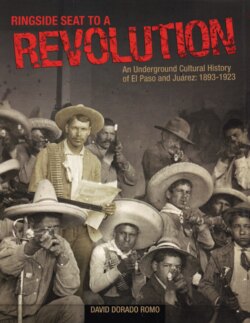Читать книгу Ringside Seat to a Revolution - David Dorado Romo - Страница 49
На сайте Литреса книга снята с продажи.
Оглавлениеher family packed all their belongings and boarded a
train at the Southern Pacific depot where several hun-
dred El Paso Mexicans gathered to bid her farewell.
The El Paso Times described the frenzied scene
at her departure on June 11, 1897:
She drove up to the depot in a carriage
accompanied by an armed escort, her father,
whose belt fairly glittered with cartridges,
her brother, who walked behind her with a
Winchester in his hands ready for action, and
a third man wearing a belt of cartridges and
with the butt of a gun protruding from the
scarf around his waist.
Santa Teresa was dressed in pure white.
Hundreds made frantic efforts to reach her
side. In the crowd that swarmed around
Teresa were a number of elegantly dressed
and aristocratic looking Mexican women,
who pressed close around the young saint-
ess, exhibiting for her great fondness.
The crowd strived to attract the atten-
tion of Santa Teresa. They kissed her hands,
kissed her veil and pressed to their lips the
hems of her white shawl. And that wonder-
ful, untutored girl of nineteen summers (sic)
received all of this homage with the grace
and dignity of a queen. She smiled continu-
ously on those around her and had a kind
word for each one who pressed her hand to
their lips.
One woman explained her devotion to
Teresa. “She nursed my children day and
night when I was sick and she divided what
she had to eat with all of us. I have seen her
tired and hungry with no beans or meat in
the house, but she never complained and
always gave us the same sweet smile. That is
why I would give my life for her.”
After she entered the car mothers would
lift their babies up to the window for Santa
Teresa to lay her pretty hands on their head.
The young saintess shook hands from the
car window until she was so fatigued that
she had to lower the window to get rid of
further exercise in that line and waved the
crowd away with her hand and with that
gentle smile they could not resist.102
Before departing, Teresita urged the crowd not to
lose faith, “I am leaving El Paso but I hope to come
back here some day.”
44
Page 45: The Ornithopter—which Ochoa also called
the New Jersey Devil—had a propeller in the front
rather than the back like most of the other flying
machines at the time, 1909. (Victor Ochoa Papers,
Archives Center, National Museum of American
History, Behring Center, Smithsonian Institution.)
102
El Paso Times, June 12, 1897.
